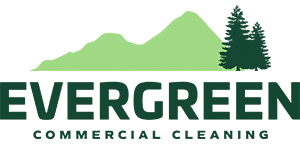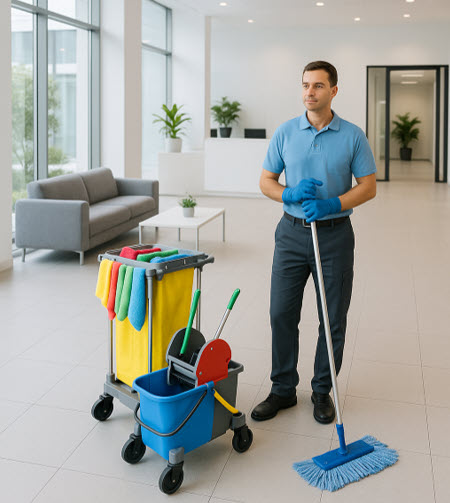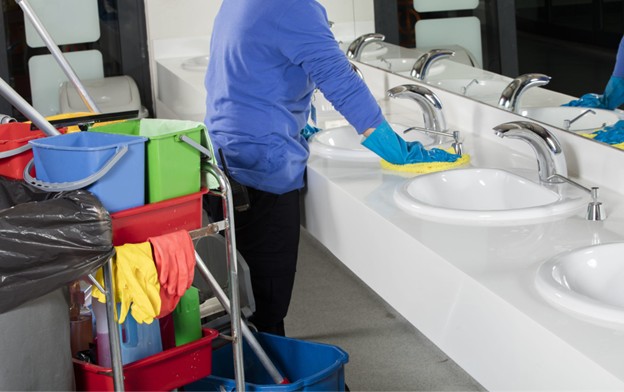Why Germ Control Matters
Every day, hundreds of people touch the same doors, wash their hands in the same sinks, or share the same office spaces. Germs move fast in these environments and once they spread, they’re hard to stop.
That’s why cross-contamination prevention is one of the most important parts of professional cleaning. It’s not just about wiping down surfaces. It’s about cleaning in a way that stops germs from traveling from one place to another.
Think about this: the same cloth that cleans a lunchroom counter should never be used in a restroom. A mop used on a bathroom floor should never touch an office lobby. Without clear systems and discipline, germs can move from the dirtiest areas of a building straight into the places people eat, meet, and work.
At Evergreen, we use science-backed cleaning methods, like color-coded tools and strict top-to-bottom cleaning sequences, to make sure germs don’t get the chance to spread. These protocols aren’t complicated, but they make a world of difference in keeping your staff, tenants, and visitors healthier year-round.
This blog will break down the exact steps Evergreen takes to stop cross-contamination and why these strategies are so effective in offices, washrooms, and healthcare facilities.
What Cross-Contamination Really Means
Cross-contamination sounds like a technical term, but the idea is simple: it’s when germs from one place get carried into another.
It happens more often than most people realize. A cloth wipes down a restroom sink and then gets used on an office desk. A mop bucket that was filled in the washroom is rolled into a lunchroom. Even a cleaning cart that doesn’t separate tools can spread germs from one area of the building into another.
The result? Germs move from the dirtiest, highest-risk spots, like toilets, sinks, and garbage bins, into places where people are meant to feel safe and comfortable. In offices, that can mean more sick days. In washrooms, it means germs lingering on surfaces long after they should have been disinfected. And in healthcare facilities, it can be the difference between a healthy environment and one that puts vulnerable people at risk.
Public health experts agree that cross-contamination is a leading factor in how illnesses spread in shared environments. The Centers for Disease Control and Prevention notes that germs move easily through indirect contact—when they’re carried from one surface or area to another without people realizing it.
That’s why Evergreen makes cross-contamination prevention one of our top priorities. By putting clear systems in place for every building we clean, we cut off one of the biggest pathways germs have to spread.
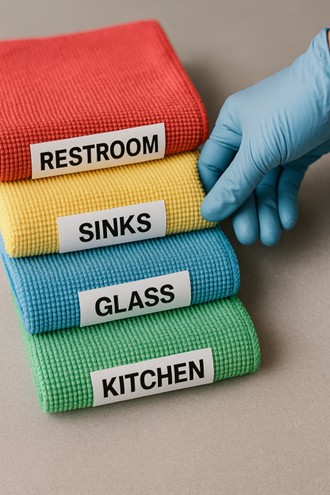
Evergreen’s Color-Coded Cleaning System
One of the easiest ways to stop germs from spreading is also one of the most effective: color coding.
At Evergreen, every cloth, mop, and bucket is assigned a color based on where it can be used. That way, the tools used in washrooms never touch desks, lunchrooms, or reception areas. It’s a simple system that removes the guesswork for our staff and gives our clients confidence that each area of their building is being cleaned the right way.
Here’s how it works:
- Red – Used only for high-risk areas like toilets and urinals.
- Yellow – For restroom surfaces such as counters, sinks, and mirrors.
- Blue – For general areas like desks, glass, and low-touch surfaces.
- Green – For specialty areas like kitchens, food prep zones, or touch-up cleaning.
This way, there’s no chance of a cloth from the restroom sink ending up on a conference room table. It’s an immediate safeguard against one of the biggest causes of germ transfer.
Color coding also makes training faster and easier. New staff don’t have to memorize a list of “do’s and don’ts.” The colors do the talking. And because Evergreen backs this with regular inspections and supervisor checks, we know the system is being followed consistently.
It’s just one of the ways we turn cleaning into a science, so every space we maintain stays clean, safe, and healthy.
Learn more about Evergreen’s Janitorial Services here.
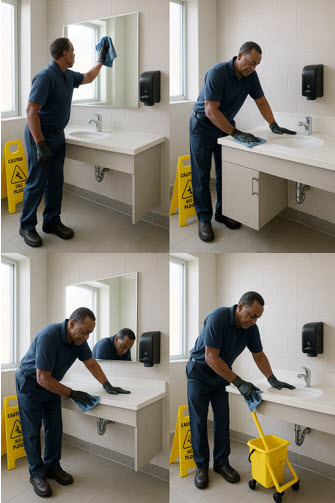
Top-Down, Clean-to-Dirty Cleaning Sequences
When it comes to stopping germs, the order you clean in matters just as much as the tools you use.
At Evergreen, our staff are trained to always clean from top to bottom and from clean areas to dirty areas. This prevents dirt, dust, and germs from being reintroduced onto surfaces that were already cleaned.
Here’s what that looks like in practice:
- Top to bottom – Start with high surfaces like shelves, mirrors, or counters. Finish with the floors. Gravity does its work, and nothing “falls” onto a freshly cleaned surface.
- Clean to dirty – Begin with the least contaminated areas, like desks or sinks, before moving to high-risk spots such as toilets, garbage bins, or floors.
It sounds simple, but this sequence makes a huge difference. Without it, germs from a toilet could end up back on a sink handle, or dirt from the floor could end up on a countertop.
This systematic approach is especially important in restrooms and healthcare environments where the germ load is much higher. By always working from clean to dirty, our staff make sure germs are trapped and removed, not spread around the room.
It’s another way Evergreen turns routine cleaning into a measurable, science-backed process that helps reduce illness and create healthier spaces for everyone who walks through your doors.
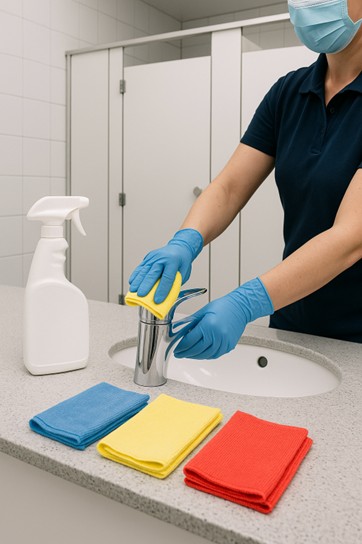
Special Protocols for Washrooms
If there’s one area in a building that demands extra attention, it’s the washroom. Germs multiply fast here, and without strict protocols, they can spread into the rest of the facility.
At Evergreen, we use dedicated tools and methods to make sure washrooms are cleaned to the highest standards and kept separate from other spaces.
Here’s how we do it:
- Dedicated equipment – Red and yellow cloths, mops, and buckets are set aside only for washroom use. They never leave the restroom area.
- High-touch surfaces – Handles, faucets, dispensers, and stall doors are disinfected every shift to prevent germ transfer.
- Top-to-bottom cleaning – Mirrors, counters, and sinks are cleaned before toilets and floors, following the clean-to-dirty rule.
- Restocking sanitary supplies – Soap, paper towels, and tissues are monitored and replenished so employees and visitors can keep hands clean.
- Odor and bacteria control – Regular disinfecting prevents buildup and keeps washrooms smelling fresh.
Washrooms are one of the highest-risk spaces for cross-contamination, which is why we give them extra care. By separating equipment, disinfecting properly, and staying on top of supplies, we stop germs from traveling into the offices, kitchens, or meeting rooms where people spend most of their time.
High-Stakes Environments: Healthcare and Sensitive Facilities
Some spaces simply can’t afford mistakes. Clinics, long-term care homes, and labs all require the strictest cleaning standards because the risks of cross-contamination are so much higher.
In these environments, germs aren’t just an inconvenience, they can directly affect vulnerable patients, residents, and staff. That’s why Evergreen follows provincial health guidelines, WHMIS standards, and infection prevention best practices to ensure every detail is handled correctly.
Here’s how we approach healthcare and other sensitive facilities:
- Dedicated tools and equipment – Washrooms, patient rooms, and medical areas each have their own supplies to prevent crossover.
- Disinfection protocols – Surfaces are cleaned and disinfected with approved products to meet healthcare standards.
- Strict sequences – Cleaning is always performed in a way that prevents re-contamination (clean-to-dirty, top-to-bottom).
- Staff training – Evergreen employees receive ongoing instruction in WHMIS, cross-contamination prevention, and safe product handling.
- Compliance audits – Supervisors conduct regular inspections to make sure standards are consistently met.
Health Canada stresses the importance of preventing cross-contamination in healthcare, noting that infection prevention relies heavily on strict cleaning and disinfection procedures (Health Canada – Infection Prevention and Control).
At Evergreen, we take that responsibility seriously. Our teams understand that in healthcare and other sensitive environments, there’s no room for error and that’s why our protocols are built to protect those who need it most.
The Benefits: Healthier Facilities, Healthier Teams
When cross-contamination is under control, everyone feels the difference. A building that’s cleaned with science-backed protocols doesn’t just look better, it creates a healthier environment for the people inside.
Here’s what our clients see when Evergreen’s prevention systems are in place:
- Fewer sick days – By reducing the spread of germs, employees are less likely to catch seasonal flu, colds, or other infections.
- Better air quality – Less dust and bacteria means fewer allergens floating around.
- Higher productivity – Healthy employees focus more on their work and less on being sick.
- Stronger trust – Visitors, tenants, and staff notice when a building is truly well cared for. It shows your business takes health and safety seriously.
- Consistent cleanliness – With clear systems like color-coding and top-to-bottom cleaning, the results are reliable every time.
Industry experts agree: prevention pays off. Dr. Elaine Larson, a leading infection control researcher, has noted that consistent hygiene practices are one of the most effective and affordable ways to reduce illness in shared environments.
It’s proof that cross-contamination prevention isn’t just about cleaning, it’s about investing in the health, safety, and success of your workplace.
Conclusion: Stopping Germs Before They Spread
Cross-contamination might sound like a small detail, but it makes a big impact. Without the right systems, germs travel quickly from restrooms to desks, from floors to counters, from one room to the next. The result? More illness, more downtime, and less trust in the cleanliness of your facility.
The good news is that cross-contamination is preventable. Evergreen’s cleaning protocols, color-coded tools, top-to-bottom sequences, and strict standards for washrooms and healthcare, are designed to stop germs in their tracks.
When you partner with Evergreen, you’re not just getting a cleaning service. You’re getting a science-backed system that protects your people, your property, and your reputation every single day.
Learn how Evergreen’s cleaning protocols protect your team’s health year-round.
